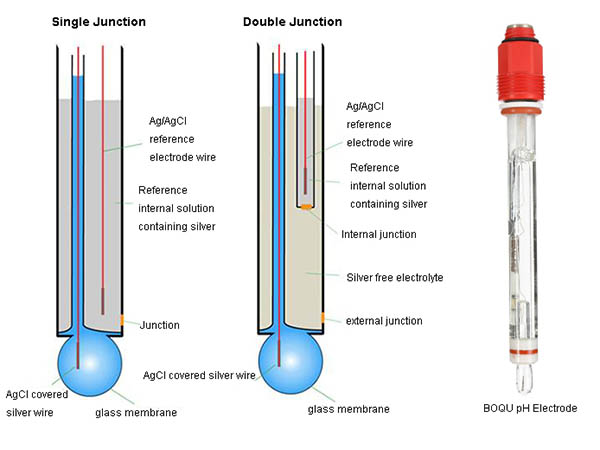PH electrodes differ in a range of ways; from tip shape, junction, material and fill. A key difference is whether the electrode has a single or double junction.
How do pH electrodes work?
Combination pH electrodes work by having a sensing half-cell (AgCl covered silver wire) and a reference half-cell (Ag/AgCl reference electrode wire), these two components must be joined together to complete a circuit in order for the meter to get a pH reading. Whilst the sensing half cell senses the change in pH of solution, the reference half cell is a stable reference potential. Electrodes can be liquid or gel filled. A liquid junction electrode creates a junction with a thin film of filling solution at the tip of the probe. They usually have a pump function to allow you to create a fresh junction for every use. They do need refilling regularly but offer the best performance increasing lifetime, accuracy and speed of response. If maintained a liquid junction will have an effective eternal lifetime. Some electrodes use a gel electrolyte which does not need to be topped up by the user. This makes them a more fuss free option but it will limit the lifetime of the electrode to approximately 1 year if stored correctly.
Double Junction – these pH electrodes have an additional salt bridge to prevent reactions between the electrode fill solution and your sample which would otherwise cause damage to the electrode junction. They are required to test samples that contain proteins, heavy metals or sulphides
Single Junction – these are for general purpose applications for samples that won’t block up the junction.
What type of pH electrode should I be using?
If a sample has proteins, sulphites, heavy metals or TRIS buffers the electrolyte can react with the sample and form a solid precipitate that blocks up the porous junction of an electrode and stops it working. This is one of the most common causes of "dead electrode" that we see time and time again.
For those samples you need a double junction – this provides an extra protection against this happening, so you'll get a much better lifetime out of the pH electrode.

Post time: May-19-2021

